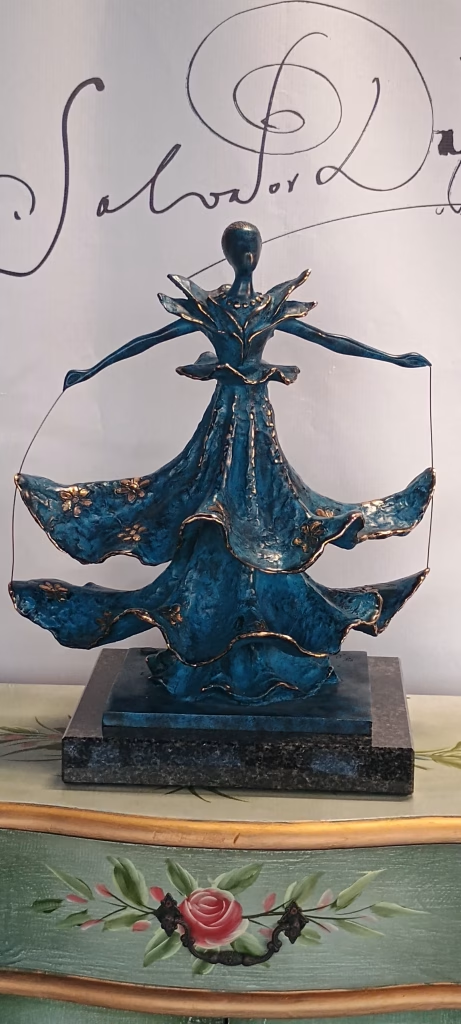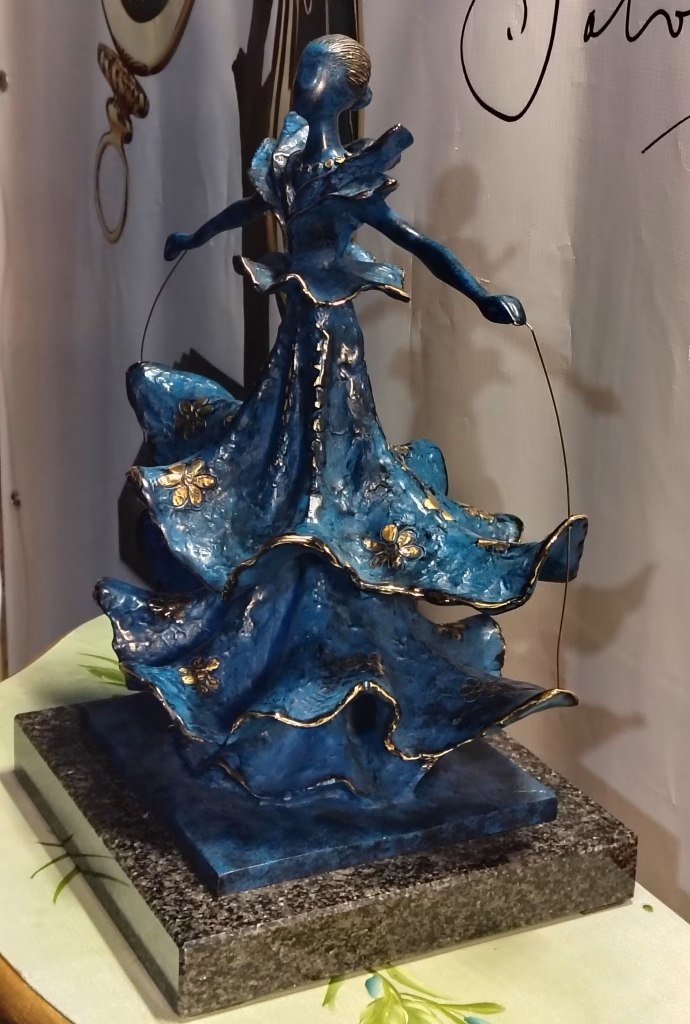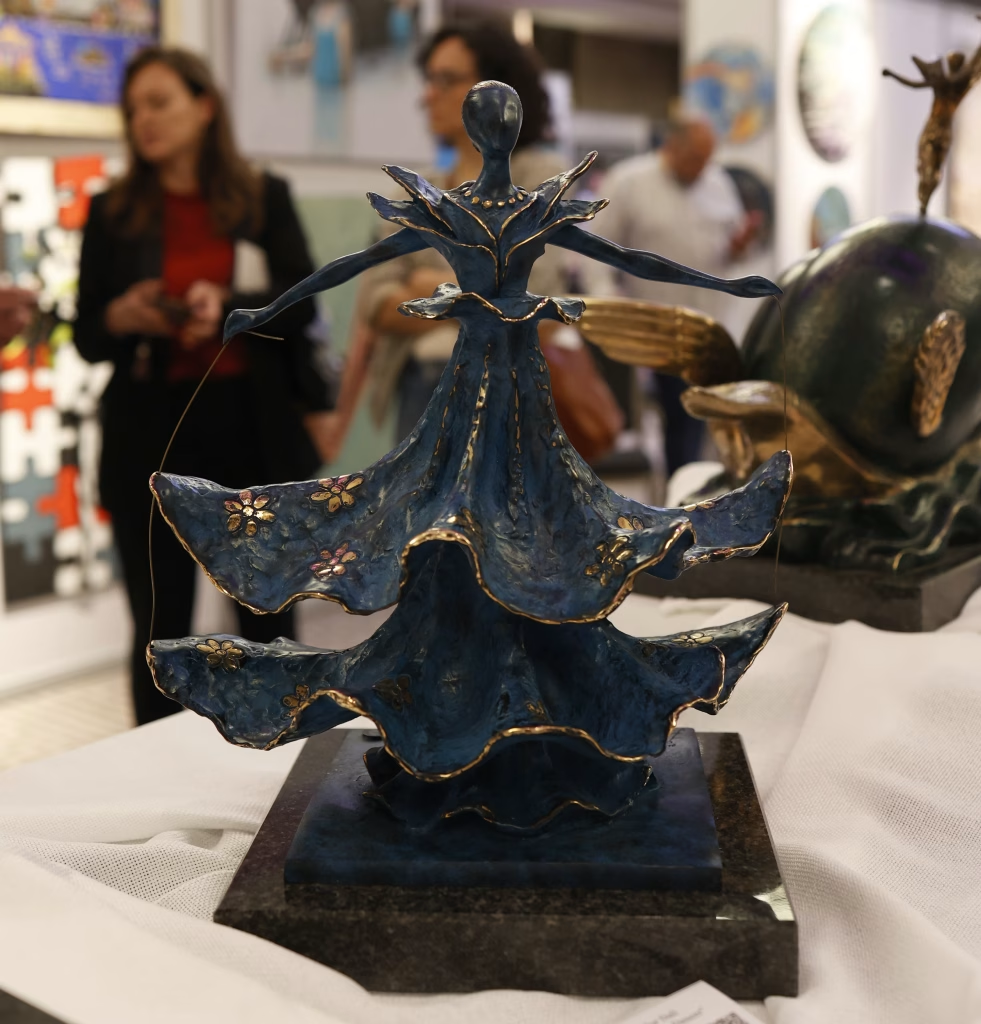Salvador Dali, one of the most celebrated surrealist artists of the 20th century, remains a symbol of boundless creativity, eccentric genius, and symbolic complexity. Among his many fascinations, ranging from time and dreams to religion and the subconscious, dance held a special, if sometimes overlooked, place in his artistic universe. This deep appreciation for dance manifests powerfully in his bronze masterpiece: Dalinian Dancer, a sculpture that captures movement, femininity, and transformation with dreamlike precision.
More than just a figurative representation, this Dalí sculpture is a metamorphic ode to movement, memory, and emotion. It channels his unique worldview, where no form is ever static, and no identity remains singular. Salvador Dali´s Dalinian Dancer is a striking fusion of strength and delicacy, solidity and rhythm, mystery and revelation.

Dance as a Gateway to Surrealism
Dalí’s interest in dance wasn’t purely aesthetic. For him, the body in motion became a metaphor for transformation, a vehicle to express emotions that defied logic. In particular, Dalí was drawn to the flamboyant energy and emotional range of flamenco. This traditional Andalusian dance—known for its intricate footwork, expressive hand movements, and dramatic postures—was much more than entertainment; it was an emotional ritual. In flamenco, the dancer becomes an instrument of human feeling, echoing joy, sorrow, pride, and transcendence.
Dalí absorbed this philosophy and reimagined it through his surrealist lens. The Dalinian Dancer embodies this idea. With her arms extended, hair tightly pulled back into a graceful chignon, and her long dress exploding in elegant, almost centrifugal ruffles, the dancer seems caught in a moment of eternal spin—her form frozen, but her motion palpable.
From the arms extended widely to the dynamic folds of her skirt, every element of this Dalinian sculpture contributes to the illusion of perpetual movement. Dalí has created not just a figure, but an entire performance, a living burst of passion cast in solid bronze.
Material Paradox: The Lightness of Bronze
One of the most arresting qualities of the Dalinian Dancer is the paradox it presents: a dancer, the symbol of lightness and fluidity, sculpted in a material as dense and weighty as bronze. Yet somehow, Dalí makes it work. The bronze does not restrict the dancer’s motion; instead, it intensifies it. The contrast between medium and subject is essential to the sculpture’s surreal impact.
The heavy bronze becomes a tool of illusion. The folds of the skirt seem to ripple with kinetic energy, spreading outward like waves from a centerpoint. As the viewer moves around the sculpture, the shining edges of the ruffles catch the light in shifting patterns, reinforcing the idea that the dancer is rotating endlessly, a celestial body in motion.
The Dancer´s posture is strong and lifted, rooted in the earth but aspiring to the heavens. It’s a balancing act between gravity and grace—much like dance itself. This tension between mass and motion speaks directly to Dalí’s broader artistic vision: one in which opposites coexist and boundaries blur.
Symbolism in Style: Flamenco and Feminine Power
The Dalinian Dancer is unmistakably feminine, not just in form but in spirit. Her outfit, modeled after a traditional flamenco dress, is layered with significance. Flamenco dresses are not just costumes; they are cultural statements, symbols of passion, pride, and drama. Dalí’s decision to incorporate a flamenco aesthetic into the sculpture aligns perfectly with his love for Spanish tradition and his fascination with expressive, theatrical modes of being.
The long gown, adorned with volants (ruffled layers), swirls as if caught mid-twirl. The sculpted ruffles emphasize volume, texture, and rhythm. This connection to flamenco is no coincidence. Dalí admired the way flamenco captured the full range of human emotions, and how the dancer’s movement could elevate raw feeling into a kind of spiritual expression.
By sculpting his dancer in the image of a flamenco performer, Dalí is not only paying homage to Spanish culture but also exploring the idea of transformation through artistic expression. The dancer becomes more than a woman; she becomes an idea in motion, unstoppable, unpredictable, and utterly captivating.
This elevation of the female form into a symbol of motion, grace, and power is a recurring theme in Dalí’s work. Unlike the passive muses of classical art, the Dalinian Dancer is active, she performs, she transforms and enchants.
The Illusion of Eternal Dance
What makes this sculpture so enchanting is Dalí’s ability to freeze a moment without losing its essence. The Dalinian Dancer isn’t simply standing; she is mid-spin. Her head is slightly tilted, her arms elegantly positioned as if guiding invisible rhythms in the air. The motion is not suggested—it is sculpted into the very anatomy of the piece.
It is this unique approach that elevates the work into the realm of surrealism. The dancer seems to exist in a space beyond time. She doesn’t just perform a dance; she becomes the dance itself. In this way, the Dalinian Dancer echoes other iconic Dalí sculptures that explore transformation, eternity, and the ephemeral nature of existence, such as the famous Dance of Time series, the Profile of Time or, strictly bound to a metamorphosys driven by music and dance, the Surrealist Piano.
In the Dalinian Dancer the movement is not cosmic or abstract, it is deeply human, intimate, and physical. The dance draws from memory, culture, and dream. It is rooted in the earth of Salvador Dali’s homeland, spun by the winds of surreal imagination.
A Dance of Roots: Dalí, Catalonia, and the Sardana
To understand the deeper layers of meaning embedded in the Dalinian Dancer, we must turn our gaze toward Dalí’s roots in Catalonia, a land of distinct traditions, passionate artistry, and resilient identity. Among its cultural treasures is the Sardana, a traditional music and circle dance that symbolizes unity, pride, and community among Catalans.
This communal dance, typically performed in open squares to the rhythm of live music, is characterized by dancers holding hands in a closed circle, moving rhythmically in synchrony. Men and women alternate in the circle, raising their arms gracefully as their steps flow with deliberate elegance. What’s fascinating is the subtlety—there are no flamboyant leaps or extravagant gestures. The power of the Sardana lies in its harmony, its cohesion, and its unwavering circular motion.
Dalí’s father, a devoted admirer of Catalan culture, was particularly fond of this music and the dance that came with it. Growing up in this environment, young Salvador absorbed the significance of the Sardana not only as a folkloric event but also as a metaphor: a celebration of collectivity and movement, a visual and symbolic embrace of form and freedom.
This influence quietly but powerfully informs the Dalinian Dancer. Though visually more reminiscent of a flamenco performance, the sculpture’s spiraling motion, rhythmic flow, and circular energy echo the choreography of the Sardana. Her pose is not random—it spirals with purpose, drawing the eye into a circular orbit of visual and emotional rhythm. She becomes a solitary participant in a dance of many, connected to a lineage of tradition and transformation.
Circular Motion and the Choreography of Symbols
One of the most remarkable aspects of Salvador Dali Dalinian Dancer is how its choreography unfolds in sculpture. The dancer, though alone in form, appears to engage with an invisible circle. Her skirts flare outward in rippling layers, mimicking the centrifugal effect created by twirling motion. In this design, Dalí creates a visual vortex that draws the viewer inward—and upward.
Seen from above, the shape of her skirt blooms outward in a circular array. This bird’s-eye perspective reveals a hidden layer of meaning. The dancer is not just spinning—she is blooming. Her swirling ruffles take on the appearance of flower petals, caught mid-bloom, animated by the wind of her dance.

This idea of circularity is not only aesthetic; it’s conceptual. Dalí was a master of looping time, of folding symbolism into form. In his paintings and sculptures, movement often triggers transformation, and transformation often loops back into identity. The Dalinian Dancer is no exception. Her circular posture reflects both the choreographic roots of Sardana and the psychological rhythm of Dalí’s work.
Just like time in Dalí’s melting clocks is not linear, movement in the Dalinian Dancer is not sequential—it is eternal. Her dance does not begin or end; it simply exists. The viewer does not witness a performance but rather steps into a moment caught in infinite rotation.
Floral Forms and the Language of Petals
Perhaps the most poetic metamorphosis within the Dalinian Dancer occurs in her visual evolution into a flower. Dalí was deeply fascinated by floral imagery—especially the flower as a metaphor for beauty, fragility, and transcendence. In this sculpture, that metaphor is brought to life through form, structure, and symbolism.
If you look at the dancer from a higher angle, her flared ruffles blossom like a flower in full bloom. This optical transformation—where a woman becomes a flower—is quintessentially Dalinian. It echoes the same kind of dual imagery and visual metamorphosis found in his famous work Profile of Time, where the rigid watch is softly deposed on a tree and morphs effortlessly into Dali´s face. This optical illusion, or “double image,” was one of the artist´s most powerful artistic devices.
Here, the double image occurs through movement and perspective. At eye level, the sculpture is clearly a dancer mid-performance, the layers of the spinning gown however clearly recall the shape of petals. From above, she morphs into a flower, a surreal lotus, recreated in bronze. The metamorphosis is not only clever, it is emotional. It evokes the bloom of the human soul through art and movement.
Each fold of the dancer’s gown serves a dual function: to suggest motion and to resemble petals. The connection between movement and blooming reflects the idea that transformation is the natural consequence of rhythm, of harmony, of flow. The dancer does not simply imitate a flower; she becomes one, through the act of dancing.
In this, the sculpture transcends its subject and enters the realm of symbolic poetry. The Dalinian Dancer represents not just a human figure, but an existential moment—where body, nature, and spirit converge in a gesture of blossoming.
Dalí and the Obsession with Flowers
Dalí’s preoccupation with flowers wasn’t limited to this sculpture. In his personal writings, particularly Diary of a Genius, he made references to the sensual, almost ritualistic presence of flowers in his daily life. “As usual, a quarter of an hour after breakfast, I slip a jasmine flower behind my ear,” he wrote—a small gesture that encapsulates his pursuit of beauty in the mundane.
Jasmine flowers appear in numerous Dalinian artworks, either explicitly painted or subtly implied. For Dalí, flowers represented more than botanical elegance; they were symbols of seduction, fleeting life, and ecstatic transformation. The way a flower opens, releases fragrance, and fades is akin to the surrealist philosophy of ephemerality and subconscious revelation.
In this context, the Dalinian Dancer is not only a dancer or a flower, it is both. It is the expression of a fleeting gesture cast into permanence. It is a surreal contradiction: a moment of ephemeral bloom rendered in eternal bronze.
This duality, fluid and fixed, light and heavy, human and floral, is the beating heart of the Dalinian Dancer. It is what gives the sculpture its haunting beauty and its lasting emotional resonance. It’s what allows it to hold space among other Salvador Dali limited edition sculptures, not only as a collector’s object but as a profound work of symbolic art.
Metamorphosis in Motion: The Dancer’s Surreal Evolution
If there is one central theme that weaves through the entire body of Dalí’s work, it is metamorphosis. From the dreamscapes of his surrealist paintings to the liquid forms of his sculptures, transformation is more than a motif, it is a law of nature. In his universe, nothing is ever what it seems, and everything is always becoming something else. Salvador Dali´s Dalinian Dancer is a perfect embodiment of this philosophy.
The dancer, caught mid-motion, is not only performing a dance—she is undergoing a transformation. Through the act of spinning, her physical form begins to evolve into something entirely new. The circular momentum of her movement becomes the catalyst for her metamorphosis. Her arms, her posture, the explosion of her gown, all suggest a woman in the process of becoming something beyond human: a vision, a flower, a symbol.
This concept mirrors the principle of “double image” that the artist so famously employed in many of his paintings, where one object transforms into another depending on the angle or context. In The Metamorphosis of Narcissus, a hand becomes an egg, and in Swans Reflecting Elephants, the reflections twist the identity of the creatures. In the same surreal vein, Salvador Dali´s Dalinian Dancer walks the line between physical identity and poetic abstraction.
Seen from one angle, she is a dancer in the throes of ecstasy; from another, she is a blooming flower. Both images are true, and both coexist. This duality is what gives the sculpture its hypnotic power. The metamorphosis is not just visual, it is symbolic, metaphysical, and deeply Dalinian.
Equilibrium as Transformation
Central to this transformation is the concept of equilibrium, a trait Dalí explored both in philosophy and in form. The Dalinian Dancer is a masterclass in balance. She stands on a narrow base, held in poise by a graceful yet powerful posture. Her arms reach outward while her core remains centered. This isn’t just a physical balance; it’s an existential one.
The sculpture embodies the tension between the forces of change and the need for stillness. It is the dance itself, rooted in rhythm, yet constantly flowing, that becomes the agent of metamorphosis. It’s in the equilibrium of the dancer’s spin that the transition from human form to floral abstraction occurs. This is the surreal secret of the sculpture: movement and balance are not opposites; they are interdependent. One fuels the other.
In this way, Salvador Dalí’s dancer speaks to the broader surrealist idea of revealing the unconscious through unexpected harmonies. Just as dreams defy the logic of waking life, this sculpture challenges the logic of physical form. The balance achieved in this piece is not about symmetry, it is about emotional, spiritual, and imaginative alignment.
The result is a figure that transcends her body. She is no longer just a woman or even a dancer; she is a moment of transformation solidified in bronze.
The Flower Within: The Final Image
As we ascend toward the final symbolism of the Dalinian Dancer, we arrive at the most potent visual: the flower. It is no accident that when viewed from above, the dancer’s form resolves into a flower in bloom. Her flared skirt, her extended arms, the motion captured in metal, all resolve into a shape that is not mechanical, but organic.
Dalí, as we’ve seen, was captivated by the ephemeral elegance of flowers. For him, they were more than objects of beauty, they were mirrors of human experience. A flower blooms, radiates fragrance and form, and then fades. It is a symbol of transience, of metamorphosis, of glory and decline. It is nature’s surreal sculpture.
In this Dali limited edition artwork, the flower becomes the final phase of the dancer’s journey. Through motion, she transcends her human form and blossoms into something greater. The metamorphosis is both literal and metaphoric. Her body becomes petal; her soul becomes perfume.
And in typical Dalinian fashion, this transformation is not just beautiful, it is also unsettling. The viewer is left with a feeling of wonder tinged with mystery. What is the dancer’s final identity? Is she still human, or has she become something entirely different? Is she dancing, or is she blooming? Dalí offers no answers, only images.

A Sculpture of Dreams: The Dancer as Surreal Totem
To own or behold a Dalinian Dancer is to possess not merely a figure, but a totem of surrealist philosophy. It encapsulates Dalí’s lifelong obsession with the subconscious, the double image, and the eternal dance of change. It is a statement of movement immortalized in bronze, an ode to the fleeting and the eternal.
Each detail of the sculpture contributes to this vision. The face, devoid of details and facial features. The hadns streched out, reaching toward something invisible. The cascading layers of fabric, alive with imaginary wind and full of energy. All of it fuses together into a singular statement: that identity is fluid, and that transformation is the true language of art.
This is what makes the Dalinian Dancer such an important Dalí sculpture, not only in terms of visual impact, but also as a conceptual cornerstone of his three-dimensional work. In her flower transformation, the Dalinian Dancer is deeply human. She is a character, a body, a movement, a flower, and a dream, all in one.
The Rarity of the Real: Dalí Limited Editions and the Value of the Dancer
What sets the Dalinian Dancer apart, beyond its emotional and symbolic power, is its rarity. As part of our collectio Dalí limited edition bronze sculptures, it represents a curated selection of three-dimensional masterpieces cast according to Salvador Dali´s desire. Each edition is finite, accompanied by a certificate of authenticity and numbered to ensure its uniqueness and legitimacy.
This limitation is not a mere marketing strategy, it’s a conceptual continuation of Dalí’s fascination with time, uniqueness, and the fleeting nature of beauty. Just as a real flower blossoms only once, the Dalinian Dancer is cast in limited bloom. The knowledge that worldwide there are only a few of these sculptures adds weight to her elegance, anchoring her in the realm of investment, preservation, and connoisseurship.
Collectors, museums, and institutions that house a Dalinian dancer are not only acquiring a sculpture, they’re entering into a relationship with one of the 20th century’s most enigmatic artistic minds. Every dali sculpture in limited edition carries this dual identity: it is both a tangible artwork and a metaphysical portal, linking the physical, rational world to Dalí’s surreal one.
Moreover, the tactile nature of bronze sculpture allows for a more immersive interaction. Unlike paintings that require distance, the Ballerina Daliniana invites proximity. Viewers can walk around her, look up from beneath or down from above, watching her form shift and respond. Each angle reveals a new truth, just as dreams do when we try to interpret them.
The Dalinian Dancer in Contemporary Dialogue
Although firmly rooted in Dalí’s own stylistic language, the Dalinian Dancer, speaks fluently to contemporary art. Her focus on transformation and identity reflects ongoing conversations in the art world around change, transformation, motion, and the multiplicity of the self.

In that sense, the Dalinian dancer feels timeless. She exists both in her own era and in ours, pirouetting across decades with the same grace and mystery. Her relevance continues to bloom.
And her story continues to be told, not only in museums and private collections, but increasingly in digital catalogs, academic discussions, and immersive exhibits like Inside Dalí, where light and sound bring his visions to life for a new generation. In this evolving landscape, the Dalinian Dancer remains a figure of fascination and reverence, both grounded and eternal.
The Final Pirouette: Remembering the Bloom
As we return to the sculpture with all we’ve explored, the Dalinian Dancer reveals herself again—not as a fixed object, but as a living metaphor.
She is:
- a homage to Catalan dance, evoking the circular elegance of the Sardana
- a flamenco spirit, intense and full of passion, bursting with movement
- a celebration of coreographic flow, where petals and limbs echo each other
- a testament to metamorphosis, the surreal shift from form to form
- a reflection of Dalí’s obsession with flowers, beauty, time, and ephemerality
- a dali sculpture that, despite the weight of bronze, pulses with life
Seen from one angle, she dances; from another, she blooms. She is a dalian dancer, but also a flower—a paradox, an illusion, a masterpiece.
This is the genius of Dalí: he didn’t just create forms; he sculpted thoughts, frozen in motion. In the Ballerina Daliniana, we witness a moment captured at its peak, vibrating with kinetic energy and symbolic complexity.
The final message is one of eternal transformation. Whether placed in a grand museum, a private collection, or a public installation, this Dali limited edition work invites us to see more than what is shown—to look twice, to feel deeply, to dream vividly.
In the dancer’s pirouette, we find not just movement—but meaning. Not just grace—but growth. Not just a sculpture—but a surreal hymn to the human desire to become something more.
Do you want to see it? contact us and wel´ll be happy to direct you to the nearest gallery that exhibits it!
